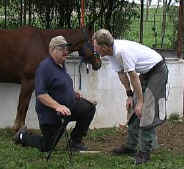
To contact Hill Country Horseshoeing School: http://www.Hillcountryhorseshoeingschool.com
Howard Saether and Janja Kovačič
Horse shoes and hoof care - page 3
 |
I (Howard) am very glad
that I spent the money and time going to Hill Country Horseshoeing School
in Texas before starting our trip. I can't imagine how we would have
come so far, without what I learned there. What we have seen of
horse shoeing so far, with a few exceptions, were usually terrifying.
Thank you Mike Chambers! To contact Hill Country Horseshoeing School: http://www.Hillcountryhorseshoeingschool.com Howard Saether and Janja Kovačič |
| Local nails go with local
shoes. Western nails don't fit peasant shoes. Most of the
shoeing in Romania is lousy. But the local shoes tend to last,
whatever some people say about calkins and toe pieces not being right.
Julian Ross |
|
I carried an Easy Boot on the first trip but
never used it. It's a heavy, bulky item, unnecessary because for my
travels in the U.S. I found farriers surprisingly easy to come by.
It only took a few days to get through wilderness areas, and I made sure
the shoes were in good order before moving into such areas. For those of
you traveling in more remote countries, you may need to pack your own
farrier supplies.
Traveling every day you will find there is nothing to pick out of your horse's hooves. Only once in 4,500 miles did a stone lodge in one of my horse's hooves, and I used a knife to pry it out. I carried a hoof pick on my first long ride (up the coast of California), but because I never used it, I didn't bother taking one on my journey with Shawnee (across the US). Depending on the mileage and terrain, the hooves may start to look like Swiss cheese from the holes produced by frequent shoeing (make sure farriers only use three nails instead of four, to minimize the Swiss cheese effect). With high mileage and rocky terrain, heavy duty shoes can wear out in as little as two weeks. If this happens, search for a farrier who can put borium shoes on for you - they wear like diamonds. Don't do it unless you must, though, because the chunky borium will inhibit the natural slide a horse makes as his hoof hits the ground, causing excessive jarring, which is not good for the joints. I never put any borium on Cacho on his 1,500 mile trip, but Shawnee got two sets with borium on our 3,000 mile trip.
Hoof moisturizer may be necessary if you are
crossing a desert. A rancher gave me a tube in New Mexico and I
used it regularly on Shawnee until I got far enough east that the ground
was not so incredibly dry. If you will be crossing a dessert it
would be appropriate to bring a thick, all purpose moisturizer such as
petroleum jelly - you can safely use that almost anywhere on the horse,
and on your own lips and hands.
Lisa Wood |
|
Mongolian horses are not shod!
Evelyn Landerer |
|
Undoubtedly
the worst "equipment" we had to deal with were the horse shoes
we had to buy in Ecuador. The steel was so soft they would be worn down
in 2 weeks, partly due to the cobbled stone roads frequently found
around small towns. I have no idea how to get round that one as horse
shoes are just too heavy to take with you. By the end of the ride our
poor horses hooves were riddled with nail holes and we had to rest up to
allow for hoof growth.
Wendy Hofstee |
| Page 1 | Page 2 | Page 3 | Page 4 | Top | Home |
| Saddles, saddle-pads & saddle-bags | Pack saddles | Horse-shoes & hoof care | ||
| Horse training | Tents | Solar power & laptops | Clothing | Camping equipment |